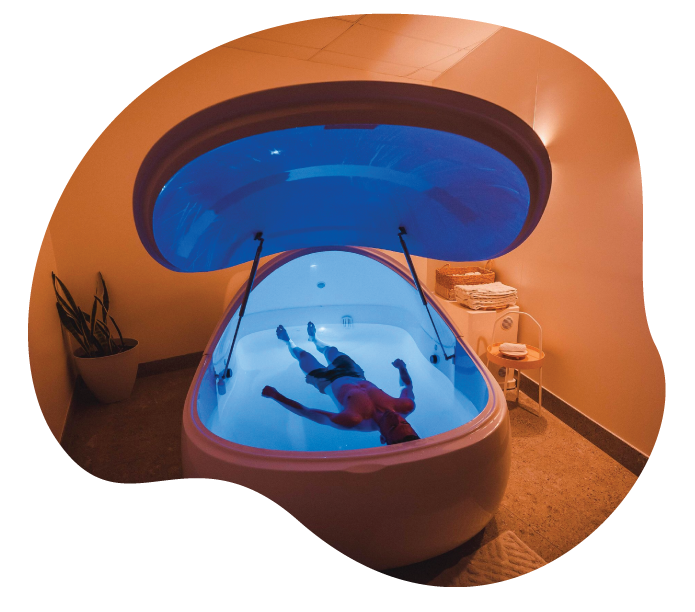Dive into Relaxation and Wellness: Discovering the Amazing Benefits of Float Therapy (aka Sensory Deprivation Therapy) for Pain Relief, Sleep Quality, and More


Grant Ian Gamble is a best-selling mindful leadership author and speaker. He has over 30 years of experience in leading teams to create innovative customer experiences, building engaged workforces, and developing leaders who prioritize mindfulness in their approach.
What is Float Therapy or Sensory Deprivation Therapy?
Float therapy, also known as sensory deprivation therapy, is a type of treatment that involves floating in a tank or pool filled with salt water. This therapy has gained popularity in recent years as a way to promote relaxation and wellness. In this article, we will explore what float therapy is and the benefits it offers.
Float therapy involves floating in a tank or pool filled with salt water. The water is heated to body temperature and contains a high concentration of Epsom salts, which allow the body to float effortlessly.
During a float therapy session, the patient lies down in the tank or pool and floats for a designated period of time. The therapy is designed to be a relaxing and meditative experience.
Benefits of Float Therapy or Sensory Deprivation Therapy
- Relaxation
Float therapy can promote relaxation by reducing stress and anxiety. The therapy can stimulate the production of endorphins, which are natural mood-boosting chemicals produced by the body.
- Pain Relief
Float therapy can provide pain relief for various conditions, including arthritis, fibromyalgia, and back pain. The therapy can help to reduce inflammation and promote healing.
- Improved Sleep
Float therapy has been shown to improve sleep quality by promoting relaxation and reducing anxiety. The therapy can also stimulate the production of melatonin, a hormone that regulates sleep.
- Enhanced Athletic Performance
Float therapy has been shown to enhance athletic performance by reducing muscle soreness and improving recovery. The therapy can increase blood flow and oxygenation to the affected area, allowing the body to recover more quickly.
- Improved Mental Health
Float therapy has been shown to improve mental health by reducing symptoms of depression and anxiety. The therapy can promote relaxation and provide a sense of calm and well-being.
Float therapy is a safe and effective treatment that offers a range of benefits for various health conditions. This treatment can promote relaxation, provide pain relief, improve sleep quality, enhance athletic performance, and improve mental health. If you are considering float therapy, it is important to consult with your healthcare provider to determine if it is a suitable treatment option for your specific condition.
Your Ultimate Recovery Guide: Unlocking the Secrets to Peak Performance, Health and Well-being

Put PEOPLE FIRST, ALWAYS and watch your business flourish.
Dive deep into the latest trends in customer experience and team engagement, mindful leadership and management. Discover practical tools and strategies that you can use to build a people-centric culture, the foundation for sustainable long-term business growth and success.
Led by mindful leadership expert, Grant Ian Gamble, a best-selling author and true visionary with over 30 years of experience in leading teams to create innovative customer experiences, building engaged, inspired and fulfilled workforces, and developing leaders who prioritize genuine connection in their approach.
The guiding principle behind all of Grant’s work is PEOPLE FIRST, ALWAYS.
More Articles:
Building a Thriving Fitness and Wellness Community: Lessons from “The Affinity Principle”
In the heart of every successful fitness and wellness business lies a thriving community, one that is engaged, supportive, and cohesive. This concept, central to my book “The Affinity Principle”, emphasizes the importance of nurturing a community where everyone – from team members to clients – feels valued and connected. Let’s explore how the principles of mindful leadership can transform any fitness and wellness environment into a flourishing community.
The Mindful Leader: Transforming Fitness and Wellness Businesses from the Inside Out
As a co-founder of AFFINITY OS™ and an advocate for mindfulness in leadership, I’ve witnessed firsthand how the core principles of mindfulness can profoundly transform fitness and wellness businesses. In today’s fast-paced and competitive environment, the success of a fitness and wellness business hinges not just on cutting-edge equipment or trendy classes, but significantly on the quality of leadership and the culture it fosters. This article explores how being a mindful leader can be a game changer in this dynamic industry.
Leverage the 2023 Fitness and Wellness Industry Trends
The world of fitness and wellness is constantly evolving, and 2023 is no exception. With a focus on holistic health and sustainable practices, the current fitness and wellness industry trends are reshaping the industry landscape. In this article, we explore the 2023 fitness and wellness trends in Australia, the Asia-Pacific region, the United States, Europe, and more, providing insights for mindful leaders in the fitness and wellness industry.
Fill out the form below and receive a PDF download of "6 Key Strategies to Engage Untapped Fitness and Wellness Market Segments"
Let's Connect!
CUSTOMER EXPERIENCE, TEAM ENGAGEMENT & WORKPLACE WELL-BEING: AFFINITY OS™ | WELLNESS INTEGRATION | MINDFUL LEADERSHIP: "THE AFFINITY PRINCIPLE"
0475 866 592

The Affinity Principle™ by Grant Gamble presents a formula for business success through a people-centric, mindful leadership approach.
PEOPLE FIRST, ALWAYS.








